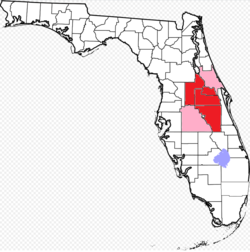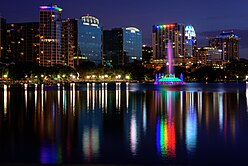Greater Orlando | |
|---|---|
| Orlando–Kissimmee–Sanford, Florida Metropolitan Statistical Area | |
From top (left to right): Downtown Orlando, Walt Disney World, Universal Studios Florida, Altamonte Springs, Celebration, and Rollins College | |
 Greater Orlando with counties with many suburbs (in dark red) and counties with few suburbs (in light red) | |
| Coordinates: 28°32′N 81°23′W / 28.54°N 81.38°W | |
| Country | United States |
| State(s) | Florida |
| Largest city | Orlando |
| Other cities | Kissimmee Sanford Saint Cloud Winter Garden Daytona Beach Deltona Winter Park Windermere Apopka Ocoee Casselberry Oviedo Clermont Winter Springs Altamonte Springs Lake Mary Leesburg Bay Lake Lake Buena Vista |
| Area | |
| • Total | 4,011 sq mi (10,390 km2) |
| Highest elevation | Sugarloaf Mountain 312 ft (95 m) |
| Lowest elevation | Sea level 0 ft (0 m) |
| Population (2020) | |
| • Total | 2,673,376[1] |
| • Rank | 22nd in the U.S. |
| GDP | |
| • MSA | $194.5 billion (2022) |
The Orlando metropolitan area (officially, for U.S. Census purposes, the Orlando–Kissimmee–Sanford, Florida Metropolitan Statistical Area) is an inland metropolitan area in the central region of the U.S. state of Florida. Its principal cities are Orlando, Kissimmee, and Sanford. The U.S. Office of Management and Budget defines it as consisting of the counties of Lake, Orange (including Orlando), Osceola, and Seminole.[3]
According to the 2020 U.S. Census, the population of Greater Orlando is 2,673,376, an increase of nearly 540,000 new residents between 2010 and 2020.
By population, it is the third-largest metropolitan area in Florida, the seventh-largest in the southeastern United States, and the 22nd largest in the United States. The MSA encompasses 4,012 square miles (10,400 km2) of total area (both land and water areas).
- ^ "Orlando-Kissimmee-Sanford, FL Metro Area Demographics and Housing 2020 Decennial Census". The Indianapolis Star. Retrieved September 9, 2024.
- ^ "Total Gross Domestic Product for Orlando-Kissimmee-Sanford, FL (MSA)". fred.stlouisfed.org. Retrieved September 9, 2024.
- ^ "Revised Delineations of Metropolitan Statistical Areas, Micropolitan Statistical Areas, and Guidance on the Uses of the Delineations of These Areas" (PDF). Executive Office of the President. July 21, 2023. p. 66. Retrieved July 21, 2023.





